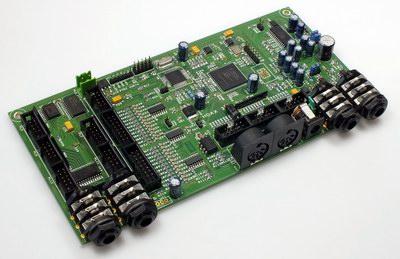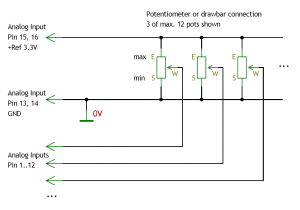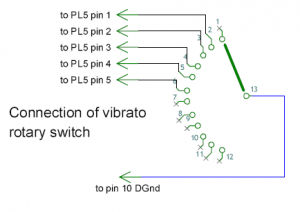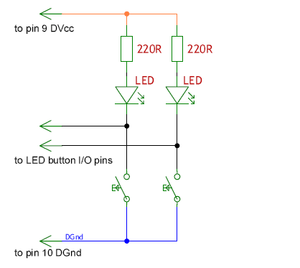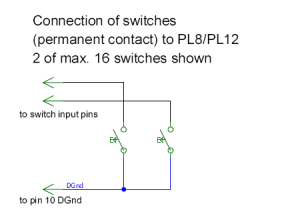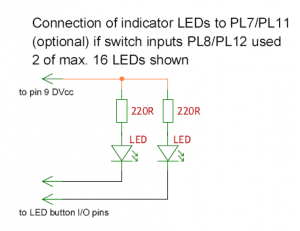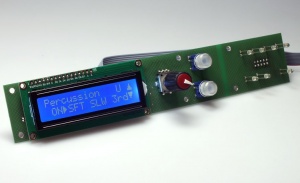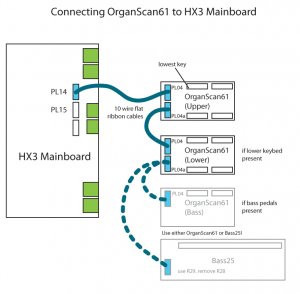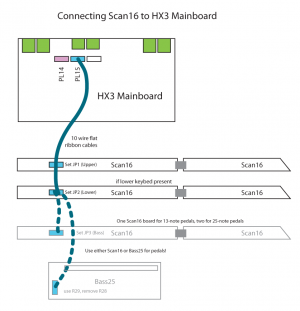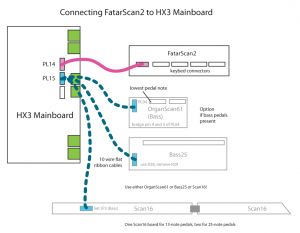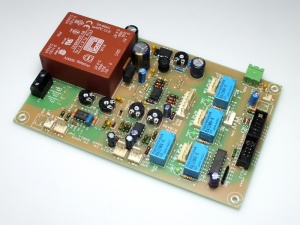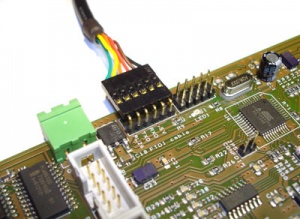HX3 Board Installation
"Hammond on a Xilinx FPGA," HX3 single-board sound engine for connecting any keyboard, for installation into existing organs or MIDI control
Installation
HX3 should be installed by a qualified technician only. You should be familiar with ribbon cable mounting, crimp contact installation and soldering of delicate parts. Important: HX3 contains static sensitive components. Be sure to use anti-static tools and grounded soldering toolset.
Please refer to board placement diagrams in our Github repository, directories PLATINEN (PCBs) and DOCS_PDF. You should have received your board with proper firmware installed and configurated for your key scanning board or MIDI input only. If you ordered a kit from distributor segor, follow soldering instructions on page Inbetriebnahme der Bausatz-Platine (sorry, german only).
First Test: Connect PL2 power connector to +5V stabilized DC supply, capable of at least 300mA. Be sure not to swap polarity; follow silk print on circuit board! You may alternatively use a wall wart type 5V supply with jumper JP12 (near DC jack) installed or 9 to 12V with jumper JP12 removed. Voltage regulator must be mounted to small heat sink for the latter case. PL2 must not be used with external power applied to DC jack. Overvoltage or interchanged polarity will destroy HX3 circuitry.
After connecting power, LED1 (red) should light up for a few seconds, subsequentially followed by LED2 (yellow) flickering. If LED1 (red) blinks fast for a while or LED2 (yellow) does not light up, FPGA image data in flash memory has been tampered or is corrupted. Please return HOAX to manufacturer for repair or re-install firmware and FPGA configuration. Flickering or "breathing" LED2 (on HOAX2) shows that HOAX engine is working.
For normal operation, only jumper JP6 must be inserted as required (MONO/2-CHANNEL), despite JP12 for 5V operation of DC jack. 2-way jumper JP6 sets MAIN/BASS output jack either to MONO or to 2-channel output (separate pedal bass on plug ring). Set JP6 to 2-CHANNEL (opposite to MONO) when using stereo Leslie simulation. JP12 disables internal 5V voltage regulator U21 for use with 5V power supplies on DC jack PL27. Remove JP12 if using 9 to 12V power on DC jack.
Use AGND and DGND pins as a "jumper rest" for spare jumpers. When ordered as kit, the "HW Test" scan core is still active and a full "C" chord should appear on organ main and Leslie audio outputs. If OK, change scan core as described in paragraph "Connecting Serial USB cable" at bottom of page. Switch off before connecting anything else.
You may omit those switches/connections/drawbars/pots you don’t plan to use. Analog inputs (drawbars/pots) should be tied to ground or to fixed level (use of trimpot) if not used, otherwise they will "float" and change sound randomly, even with preset active.
HX3 may also be used without any switches/drawbars/pots connected by selecting "Expander Mode" - see page Using HX3 with MIDI controllers. You may leave all internal connectors open if you plan to remote by MIDI only with analog control inputs disabled.
Only connect/disconnect cables or optional boards when power is off!
Connecting Drawbars
At least connect 9 drawbars or slider pots and Leslie volume control pot to PL9 Analog upper. R value should be in the 10kOhm to 47kOhm range, taper B (audio). All inputs are DC controlled. Input voltage range is from 0V (off or minimal volume) to +3.3V (max. volume). Connect MAIN/BASS audio output to amplifier. Level is in the 300 mV range.
Loud noise may be heard on MAIN/BASS output if you ordered HOAX with Fatar scan board firmware driver, as no scan board is connected yet. Otherwise, connect a MIDI keyboard to MIDI in (PL18/PL20). HX3 accepts MIDI channel 1 for upper, channel 2 for lower (both 61 notes C-C) and channel 3 for bass (25 notes C-C). Plain organ sound should be heard when playing on channel 1. Check function of all drawbars. HX3 will accept MIDI controller messages conforming to MIDI CC setting (5 to choose from).
From AVR firmware version 3.7 there are special firmwares for use with single drawbar set organs. Drawbars must be connected to PL13 (Lower) here. Drawbars are assigned automatically to manual which is currently played (or was used last). On PL9, only input pins 10 and 11 are used (Tone und Amp Volume; may be disabled by HX3 Remote parameter 481, if adusted by MenuPanel).
PL9 Analog Controller A (Upper Manual)
Pin - function
1: Drawbar 16
2: Drawbar 5 1/3
3: Drawbar 8
4: Drawbar 4
5: Drawbar 2 2/3
6: Drawbar 2
7: Drawbar 1 5/9
8: Drawbar 1 1/3
9: Drawbar 1
10: Tone Pot
11: Leslie Volume
12: Swell Pedal (do not connect if swell jack used)
13, 14: Drawbar/Pot Gnd
15, 16: Drawbar/Pot End 3.3V+ (Reference)
PL13 Analog Controller B (Lower Manual)
Pin - function
1: Drawbar 16
2: Drawbar 5 1/3
3: Drawbar 8
4: Drawbar 4
5: Drawbar 2 2/3
6: Drawbar 2
7: Drawbar 1 5/9
8: Drawbar 1 1/3
9: Drawbar 1
10: Drawbar Bass 16
11: Drawbar Bass 8
12: Drawbar/Pot Bass Sustain
13, 14: Drawbar/Pot Gnd
15, 16: Drawbar/Pot End 3.3V+ (Reference)
DC swell/volume control is active also on pin 12 of PL9. Even with MIDI control, a swell pedal should be connected to SWELL jack. This overrides MIDI volume control. You may connect a swell pedal like Yamaha FC-7 or a simple volume pot to the SWELL jack. Do not connect pin 12 of PL9 if swell jack used.
HX3 mainboard is set to tone/treble and amp volume control inputs active by factory (may be altered also with HX3 Remote or MenuPanel). Tone pot center is connected to pin 10 of PL9. If digital Leslie emulation is licenced on HX3, pin 11 becomes the Leslie amp volume/drive control (mandatory). Amp volume pot center is connected to pin 11 of PL9. Both pots begin with Gnd and end with Ref 3.3V+.
Please note: Open analog inputs (unconnected) will "float" and change randomly, even with presets active. Tie unused inputs to ground or fixed level (ie. trimpot).
Connecting Switches or Buttons
Vibrato/chorus V1 to C3 is selected by a rotary switch:
Pins PL5 Vibrato rotary switch
Pin Number - Function (active low – switch to Gnd)
nc: Vib1 (no connection)
1: Cho1
2: Vib2
3: Cho2
4: Vib3
5: Cho3
6: not used
7: not used
8: MEM LED- (optional)
9: MEM LED+ (optional)
10: Common Gnd
Pins PL7 buttons (momentary contact, optional LED) or PL8 tab/rocker switches
Pin Number - Function (active low – switch to Gnd)
1: Perc ON, like B3
2: Perc SOFT
3: Perc FAST
4: Perc THIRD
5: Vib ON upper
6: Vib ON lower
7: Leslie ON (connected LED blinks with Leslie speed)
8: Leslie FAST
9: (+5V, used only for button LEDs supply, e.g. on Panel16)
10: Common Gnd
Up to 16 buttons or tab switches may be connected to PL7, PL11 or PL11/PL12. You may either use a button or a tab switch for each function, also mixed, but not both on same function. If using buttons, a indicator LED should be installed as shown; otherwise there is no indication if a function is on or off.
Pins PL11 buttons (momentary contact, optional LED) or PL12 tab/rocker switches
Pin Number - function (active low – switch to Gnd)
1: Common Preset 1 (only button on PL11 - do not use pin 1 of PL12!)
2: Common Preset 2 (only button on PL11 - do not use pin 1 of PL12!)
3: Common Preset 3 (only button on PL11 - do not use pin 1 of PL12!)
4: Common Preset 4 (only button on PL11 - do not use pin 1 of PL12!)
5: EFX 1 / Reverb 1
6: EFX 2 / Reverb 2
7: Bass on Leslie (routes pedal bass also to Leslie simulation if ON)
8: Split ON
9: (+5V, used only for button LEDs supply, e.g. on Panel16)
10: Common Gnd
Every function may be activated by a button on PL7/PL11 or a switch on PL8/PL12. Pin functions are equivalent, but PL7/PL11 toggle status on every push and drive indicator LEDs (see schematic). You may omit those switches you don’t plan to use or connect corresponding pins of PL8 and PL12 permanently to Gnd if function should be ON as default.
A button panel named Panel16 with 16 LED buttons is available if you want to have a hassle-free compact solution. It connects directly to PL7 and PL11. It also contains the 4 common preset buttons.
Note for mk3 users: Tab switches are connected to PL7 and PL11 on HX3 mk3 as well as buttons, as HX3 mk3 does not provide separate switch inputs PL8 and PL12. A ButtonMask Bit (see HX3 Remote, organ params 479 and 480) must be set for each tab switch used instead of (momentary) button. The rightmost check box represents Pin 1 and so forth.
Connecting Preset Switches
HX3 may be extended to 2x8, 2x12 or 2x16 presets with optional boards Preset12 (obsolete), Preset16 (one or two) or Preset24. All connect to HX3 PL4 by 10-wire flat ribbon cable. HX3 PL4 is a I2C bus system, so all boards connect in parallel (use multiple 10-pin plugs on one cable if necessary); Preset12 and Preset16 yield an extension route-through connector for adding more boards. Cable length on HX3 PL4 should not exceed 75 cm (30") in total. See description of each product for details.
Optional Boards
Connecting MenuPanel
Connect optional HX3 MenuPanel to HX3 PL4 using a 10-wire flat ribbon cable. HX3 firmware from version 3.41 and up will recognize the MenuPanel and act accordingly. HX3 MenuPanel may be used in parallel/simultaneously with Preset12 (obsolete), Preset16 and Preset24 boards connected to HX3 PL4. Extend a flat ribbon with additional connector to your cable on HX3 PL4 or use unoccupied 10-pin header on (last) Preset16 board which also carries the PL4 signal.
Connecting OrganScan61 board set
A set of up to 3 "daisy-chained" OrganScan61 boards are connected to PL14 if HOAX was ordered with OrganScan61 firmware driver. Refer to picture. Be shure not to twist connectors (red marked ribbon lead must match with pin 1 of all ribbon cable connectors, indicated by a triangle marking). Total cable length should not exceed 1,5m. First board in row is upper manual, second is lower manual and third (rightmost in picture) is bass pedal (not completely populated since only 25 keys are present). Bass25 board may be used as an alternative to last OrganScan61 board; it has the same functionality (but different key connectors). See page Anschluss der Scan-Platine OrganScan61 (KlangComputer) (german) for more pictures.
Inputs are active low (switch to ground), so connecting them to Gnd pins 13 to 16 of PL33 (PL31 on bass) on OrganScan61 board should yield the appropriate note. See OrganScan61 schematic for connector pinout.
Keybed Connection
Pin 1 PL30 = Note 1 = lowest C 1
Pin 16 PL30 = Note 16 = D# 2
Pin 1 PL31 = Note 17 = E 2
Pin 16 PL31 = Note 32 = G 3
Pin 1 PL32 = Note 33 = G# 3
Pin 16 PL32 = Note 48 = H 4
Pin 1 PL33 = Note 49 = C 5
Pin 13 PL33 = Note 61 = C 6
Pin 14, 15, 16 PL33 = Gnd/Busbar
Pedals Connection
(or use Bass25 scan board)
Pin 1 PL30 = Note 1 = lowest C 1
Pin 16 PL30 = Note 16 = D# 2
Pin 1 PL31 = Note 17 = E 2
Pin 9 PL31 = Note 25 = C 2
Pin 14, 15, 16 PL31 = Gnd/Busbar
If unconfigured, OrganScan61 boards are activated by HX3 Remote application or serial command:
wen=1 477=0
Refer to serial interface command description (syntax table), Excel sheet in our Github repository, directory DOCS_PDF.
Connecting Scan16 board set
As an alternative to OrganScan61 a set of Scan16 strip boards may be used which yields easier installation on some keybeds. For each manual you need 3 (44 or 49 keys) or 4 (61 keys) strip boards. Please refer to schematics and part placement in out Git repo. Connection is somewhat different to OrganScan61: All Scan16 equipped manuals are wired in parallel with one 10-wire flat ribbon cable (multiple connectors attached) to HX3 PL15. Bass25 may be used as convenient alternative to pedal scan board. A jumper on "lowest" Scan16 board determines if keybed is upper, lower or bass pedal:
JP1 = Upper manual
JP2 = Lower manual
JP3 = Pedal notes
If unconfigured, Scan16 boards for one or two 61-key manuals are activated by HX3 Remote application or serial command:
wen=1 477=5
Scan16 boards for one or two 49-key manuals (spinett type organs) are activated by HX3 Remote application or serial command:
wen=1 477=4
Please note: lowest key contact pad on Strip16 is always "C" key. On 61-key manuals, upper part of rightmost Scan16 board may be cut off as marked on PCB silk screen printing (or pads are left open). On 44-key manuals, lowest 5 pads are left open, manual(s) start with "F". On 49-key manuals, connect pad PL20 to highest "C" note.
As on OrganScan61, all contacts must switch to ground. Boards provide ground lugs for connection to busbar.
Connecting FatarScan2 board
A single FatarScan2 board is connected to HX3 PL14. One or two Fatar 61 key manuals (type TP/8O or similar) may be connected to one FatarScan2 board using a special cable set (MicroMatch connectors to keyboard scanning strips). See page Anschluss der Scan-Platine FatarScan2 (german) for more pictures. We recommend buying to FatarScan2 cable set for connection to MicroMatch headers on Fatar keybeds; see page Anschluss der Scan-Platine FatarScan2 (german) for more pictures.
Bass pedals may be connected to an additional OrganScan61, OrganScan16 or Bass25 board wired to HX3 PL15 (!). FatarScan2 board is are activated by HX3 Remote application or serial command:
wen=1 477=2
Refer to serial interface command description (syntax table), Excel sheet in our Github repository, directory DOCS_PDF.
Connecting BASS25 or MIDISCAN25 board
Bass25 (refer to PDFs in our Github repo folder PLATNEN/BASS25, files *_new.PDF) may be used as an addition to FatarScan2, OrganScan61 and Scan16 boards for convenient connection of bass pedal contacts as pictured above (note different HX3 headers). Board may be placed in bottom of organ if 10-wire flat ribbon cable to HX3 or last OrganScan61 board does not exceed 1m. Please note jumper setting on Bass25:
Old version (beige PCB):
- JP6 inserted always
- JP7 2-3 inserted if OrganScan61 (daisy chain on HX3 PL14), Bass25 to last OrganScan61 board
- JP7 1-2 inserted if FatarScan2 on HX3 PL14, or Scan16 Strip and Bass25 to HX3 PL15
- JP8 2-3 inserted always
Contacts always switch to ground (busbar).
New version MIDISCAN25 (green PCB):
- JP1 solder bridge, always open
- JP2 solder bridge if used with OrganScan61 (daisy chain on HX3 PL14), Bass25 to last OrganScan61 board
- JP3 solder bridge if used with FatarScan2 on HX3 PL14 or Scan16 Strip on HX3 PL15
MIDISCAN25 provides a 26-pin flat ribbon cable connector for alternative connection of bass pedal contacts:
- Pin 1 Lowest note "C" ...
- Pin 25 Highest note "C"
- Pin 26 Common ground (busbar)
Connecting LDR/Leslie Interface Board
Obsolete - for reference only!
The LDR/Leslie Interface (see also german page LDR/Leslie-Interface-Platine and documents in Github repo folder ADAPTER) is required for direct connection of Leslie families 715, 760 and 147 without need of Combo Preamp. It contains a two-channel preamp for organ main (manuals) and pedals, a mixing stage and relais switches for Leslie control, also a power supply capable of 5V/500mA. This board is intended for skilled technicians, as it might require adjustments and re-wiring to fit your needs.
Main channel is routed either from HX3 main organ output or Leslie tube amp simulation output (recommended for use with transistor Leslies) to LDR/Leslie Interface Board's preamp. A volume pot might be inserted between preamp and mixing stage. To control Leslie speed relais, 10-pin header connect to HX3 PL12 (also additionally in parallel to other switches). Connection to HX3 PL7 on second 10-pin header is required only when a Leslie button switch is to be used (momentary "button" contact, often found on organ's swell pedal).
Green power connector carries 5V DC to supply HX3 board. Note wire jumpers for 117V or 230V mains and set operating voltage trimpot to 5.0V on green power connector.
We recommend Yamaha FC-7 type expression pedal plugged into HX3 SWELL jack, but for OEM installations in older organ consoles the LDR-to-voltage converter on Leslie I/F board may also be used. It translates swell pedal's LDR resistance to swell control voltage of HX3. SWELL jack has to be removed for this purpose. LDR stage requires proper calibration of GAIN and OFS trimpots to obtain a control voltage range of approx. 0 (soft) to 3.3V (full swell) on HX3 swell input.
Other two trimpots set preamp gain. Adjust gain for full Leslie volume. We can supply a set of 3-wire cables with plugs to connect to HX3 audio and swell. Inportant: Plug polarity reqires 3-pin headers to be installed from HX3 component side instead of 1/4" jacks. If installed from solder side, reverse pinout accordingly. Leslie connection is described in schematics of LDR/Leslie Interface Board.
Connection of Leslie interface board to 11 pin Leslie
| PL12-1 | PL12-2 | PL12-3 | PL12-4 | PL10-1 | PL10-2 | PL10-3 | Remark |
| Leslie pin 8 (slow) | Leslie pin 7 (fast) | Leslie pin 6 (power) | Leslie pin 5 (common) | Leslie pin 1 (rotary) | Leslie pin 4 (Gnd) | Leslie pin 2 (stationary) | Set HOAX JP6 to STEREO |
Connection of Leslie interface board to 9 pin Leslie
| PL12-1 | PL12-2 | PL12-3 | PL12-4 | PL10-1 | PL10-2 | PL10-3 | Remark |
| Leslie pin 7 (slow) | Leslie pin 6 (fast) | not connected | Leslie pin 1 (Gnd) | Leslie pin 2 (audio) | Leslie pin 1 (Gnd) | not connected | Set HOAX JP6 to MONO |
Connection of Leslie interface board to 147 Leslie 6-pin
| PL6-1+2 | PL6-4+5 | PL10-1 | PL10-2 | Remark |
| Leslie pin 4 | Leslie pin 5 | Leslie pin 6 (audio) | Leslie pin 1 (Gnd) | Set HOAX JP6 to MONO |
Note: Additional power relay recommended for 230V HV on 147 Leslie pin 4 and 5. Bridge pin 2 to pin 3 of Leslie 6-pin connector.
Connecting Serial USB cable
Note: For documentation purposes only. Please see new page HX3 Remote/Update Application!
For custom configuration, entering licence codes and FPGA/firmware updates, a USB-to-serial adaptor cable FTDI TTL-232R 5V must be used. Communication is established by simple clear-text commands by terminal emulation software TeraTerm 4.7x (recommended).
Parameters are 57600/8n1, send CR, receive CR+LF. As +5V is supplied by USB, external power supply may be disconnected. Do not use unpowered USB hubs as HOAX needs 250mA to run (note: on newer HX3 boards, 5V pin of PL26 may be cut off, HX3 power supply must be on). See HOAX3_syntax MS Excel table in our Github repository for command details. Update of FPGA configuration and scan cores are done by TeraTerm macros in Github TERATERM_MACRO folder. Update of firmware is done by AVRdude command batch "hoaxflash.bat". Make shure your HX3 repo is unzipped to C:\HOAX folder on your local hard drive as TeraTerm macros and Windows command batches assume this path.
Connect FTDI TTL-232 5V cable header to PL26 so black cable sits on GND pin and red cable sits on +5V pin. Plug in PL26 cable first, then connect to USB. Test connection by pressing ENTER a few times, HX3 should answer with "#0:255=0 [OK]" if connection is OK and cable driver properly installed. Please see page Inbetriebnahme der Bausatz-Platine (sorry, german language - use Google translation service) or FTDI driver download page for details on FTDI driver installation.
HX3 will restart on serial command
9999
followed by ENTER key. HX3 will output some status messages. Restart every time you change scan routine setting like below.
Serial Settings Examples
Note: For documentation purposes and older firmware versions (up to #3.5) only. Please see new page HX3 Remote/Update Application!
These settings may be useful for fundamental HX3 configuration. Please refer to HOAX_Syntax table (MS Excel or PDF) for complete list of commands. Most parameter changes could be made non-volatile (saved in AVR controller's EEPROM) with preceeding "wen=1" (write eeprom enable) command. Without "wen=1", parameters are only valid until power off.
Set MIDI only scan core 1 (no scan board connected):
wen=1 477=1
Disable own analog controllers for MIDI expander use (no drawbars/pots connected):
wen=1 478=255
Set Customer info (will also be displayed on MenuPanel):
wen=1 9990="John Doe"
Get HX3 Serial Number:
9952?
Enter Organ Licence Code (use your purchased licence number):
wen=1 9950=1234567
Enter Leslie Licence Code (use your purchased licence number):
wen=1 9951=1234567
